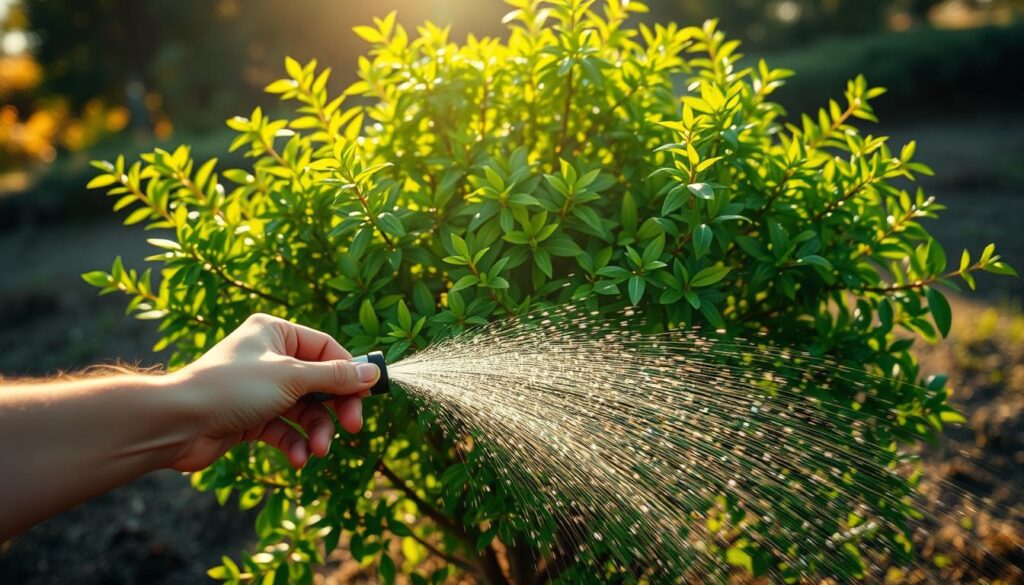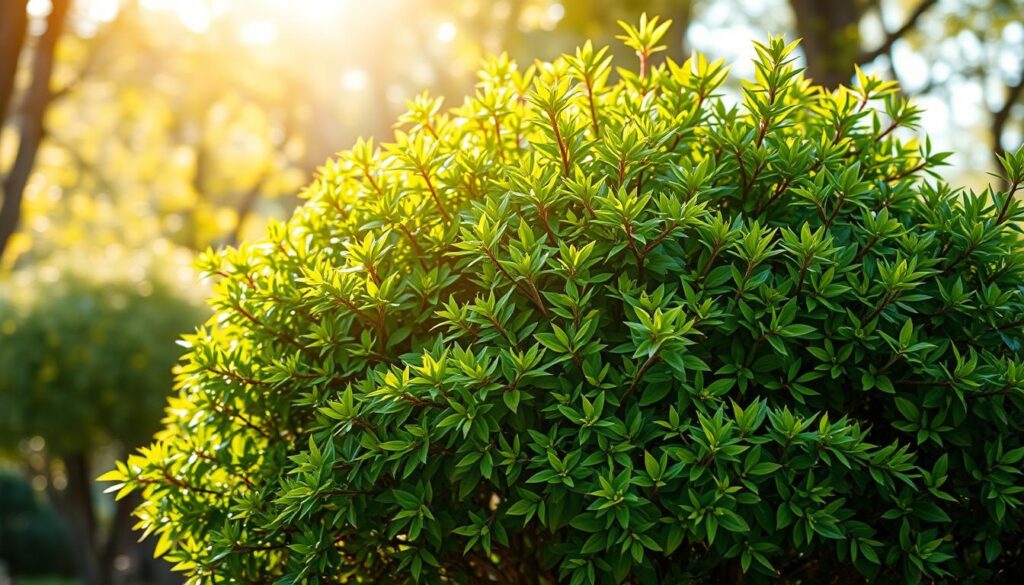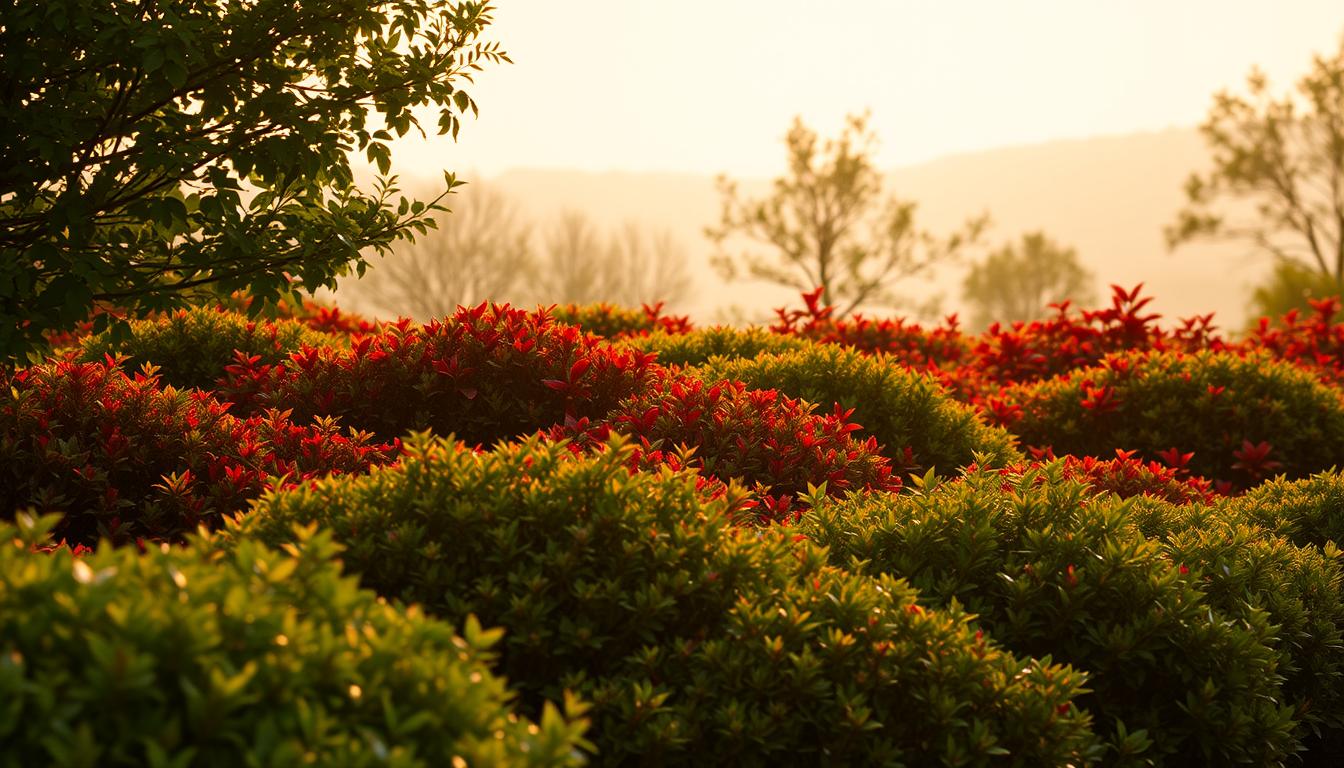My garden taught me a hard lesson years ago. I saw my beautiful leaf-shedding plants wither and struggle. They were victims of my good but wrong care. Deciduous bushes can make your garden beautiful, but only if you know how to care for them.
Growing deciduous bushes is more than just planting and waiting. It’s about knowing the seasons, the soil, and the right care. Many gardeners unknowingly harm their plants with simple mistakes. These mistakes can stop growth or even kill these amazing plants.
This guide will show you how to grow healthy deciduous bushes. You’ll learn how to avoid common mistakes and make a garden that changes with the seasons.
Table of Contents
Understanding Seasonal Leaf-Shedding Plants
Deciduous shrubs are like living art, changing your garden with the seasons. They show off different colors and textures all year. This makes them key to any garden.
Benefits of Deciduous Shrubs in Your Landscape
Your garden can become a colorful canvas with deciduous shrubs. They offer many benefits:
- Spectacular autumn colors that paint your landscape in rich hues
- Delightful spring blooms that announce the season’s arrival
- Natural structure and visual interest during different growth stages
- Enhanced wildlife habitat and ecological diversity
“Every season brings a new personality to deciduous shrubs, making them living masterpieces of landscape design.” – Landscape Design Expert
Natural Growth Cycles Throughout the Year
Deciduous shrubs have a yearly cycle. In spring, they bloom with vibrant colors. Summer brings green leaves, and autumn turns leaves into warm colors. Winter shows off their branch structures, adding beauty to your garden.
Climate Adaptation and Hardiness
These plants are great at adjusting to different climates. They shed leaves to save energy and survive cold winters. Choosing native shrubs means they’ll thrive better in your area, needing less care.
Knowing about seasonal foliage helps you create a garden that changes with the seasons. It celebrates nature’s beauty in every season.
Common Types of Deciduous Bushes
Exploring different shrubs can make your garden lively and help local ecosystems. Deciduous bushes are great for adding life to your outdoor space.
Many deciduous shrubs do well in various places, adding beauty and diversity to your garden. Here are some top picks:
- Hydrangeas: These flowering shrubs have big, colorful blooms in blue, pink, and white.
- Lilacs: Known for their scent, these shrubs bloom in spring with purple, pink, or white flowers.
- Forsythias: They bloom early in spring with bright yellow flowers, marking the end of winter.
- Viburnums: These shrubs have beautiful flowers, berries, and colorful leaves in autumn.
When picking shrubs for your garden, think about your area’s natural habitats and climate. Each bush needs specific soil, sunlight, and water to grow well.
Important things to check include:
- Mature plant size
- Sunlight needs
- Soil drainage
- Hardiness zones
Knowing about different deciduous bushes helps you create a garden that’s good for wildlife and looks great all year.
Critical Timing for Planting and Care
Choosing the right time to plant deciduous bushes is key to their health and success. Understanding the best times for planting and care is the first step in low-maintenance gardening.
When planting deciduous bushes, consider the season and local environment. Different types do best at specific times of the year.
Best Seasons for Planting
The best times to plant are usually in two seasons:
- Early Spring: When the soil is warm but before it gets too hot
- Early Fall: About 6-8 weeks before it freezes
Weather Considerations
| Season | Planting Conditions | Risk Factors |
|---|---|---|
| Spring | Moderate temperatures | Late frost potential |
| Fall | Cooling temperatures | Early winter freeze |
Soil Preparation Guidelines
Make sure your garden bed is ready for strong bush growth. Good soil preparation is essential for healthy growth and ecological balance.
- Test soil pH levels
- Remove weeds and debris
- Incorporate organic matter
- Ensure proper drainage
Pro tip: Local extension offices can provide specific guidance tailored to your region’s unique gardening conditions.
Water Management Fundamentals

Keeping your deciduous bushes healthy starts with knowing how to manage water. Your landscaping needs the right moisture balance. This balance supports plant health without harming them.
Every bush species has its own water needs. It’s important to learn what your plants need to keep your landscape looking great.
- Check soil moisture before watering
- Understand drainage characteristics
- Recognize signs of water stress
- Adjust watering based on seasonal changes
Many things affect how plants absorb water. Climate, soil type, and how mature the plants are all matter. They help decide the best way to water.
| Soil Type | Water Retention | Watering Frequency |
|---|---|---|
| Sandy Soil | Low | More frequent, smaller amounts |
| Clay Soil | High | Less frequent, deeper watering |
| Loamy Soil | Moderate | Balanced watering schedule |
You aim to keep the soil moist but not too wet. Water deeply but not often. This helps roots grow strong and bushes grow well.
“Water is the lifeblood of your garden’s ecosystem.” – Professional Landscape Experts
Watch for signs like droopy leaves or dry soil. These signs tell you when to water. Adjust your watering to keep your plants healthy and your garden beautiful.
Essential Tools and Equipment for Bush Care
Good low-maintenance gardening starts with the right tools for caring for deciduous bushes. The right equipment makes gardening easier and helps your shrubs grow well. Quality tools help you take better care of your plants.
For bush care, you need a wide range of tools. The right tools can greatly improve your gardening experience.
Pruning Tools Selection
Choosing the best pruning tools is key for your bushes. Here are the must-have pruning tools:
- Bypass pruning shears for clean cuts on smaller branches
- Loppers are designed to handle thicker branches, up to 2 inches in diameter.
- Pruning saw for larger, mature branches
- Hand pruners with ergonomic handles for comfortable use
Maintenance Equipment
You’ll also need more tools for low-maintenance gardening:
- Garden gloves for hand protection
- Wheelbarrow for moving soil and mulch
- Rake for clearing debris
- Watering can or hose with adjustable nozzle
Safety Gear Requirements
Protecting yourself is as crucial as protecting your plants. Here’s the safety gear you need:
- Safety glasses to protect eyes from debris
- Thick gardening gloves
- Long-sleeved shirts and pants
- Sturdy closed-toe shoes
Pro tip: Always clean and disinfect your tools between uses to prevent disease transmission and ensure the healthy growth of your deciduous bushes.
Proper Pruning Techniques

Pruning is key for keeping your plants healthy and your garden looking great. It’s important to prune carefully to help your bushes grow well and stay in shape.
Knowing how to prune can change how your garden looks and how well your plants do. While different bushes need different care, there are some basic steps that work for most.
- Identify the best time to prune based on the specific bush type
- Use clean, sharp pruning tools to prevent plant damage
- Make your cuts at a 45-degree angle just above a growth node.
- Remove dead, diseased, or crossing branches first
When to prune is very important. Most bushes do best when pruned in their dormant season. This is usually late winter or early spring, before they start growing again. Pruning at this time helps the plant grow better and keeps it healthy.
| Bush Type | Ideal Pruning Time | Pruning Frequency |
|---|---|---|
| Flowering Shrubs | After flowering | Annually |
| Deciduous Hedges | Late winter | 1-2 times per year |
| Fruit-bearing Bushes | Early spring | Annually |
Don’t over-prune, as it can harm your plants. Remove about 10-20% of the bush’s growth each year. This helps keep the plant healthy and supports a beautiful garden design.
Pro Tip: Always use sterilized pruning tools to prevent spreading potential plant diseases between your bushes.
Soil and Fertilization Requirements
Deciduous bushes need the right soil and nutrients to grow well. Your garden’s health depends on giving them what they need. The best soil is key for your shrubs to flourish.
Each deciduous bush has its own nutritional needs that change with the seasons. Knowing these needs is vital for keeping your plants looking great.
Seasonal Nutrient Needs
- Spring: High nitrogen for leaf and stem growth
- Summer: Balanced nutrients for sustained development
- Fall: Potassium and phosphorus for root strength
- Winter: Minimal fertilization to support dormant phases
pH Balance Fundamentals
Soil pH plays a key role in nutrient absorption. Most deciduous shrubs thrive in slightly acidic to neutral soil, with a pH range of 6.0 to 7.0.
| pH Range | Nutrient Availability | Plant Impact |
|---|---|---|
| Below 6.0 | Reduced nutrient uptake | Stunted growth |
| 6.0 – 7.0 | Optimal nutrient absorption | Healthy growth |
| Above 7.0 | Limited mineral availability | Potential nutrient deficiencies |
Organic vs. Synthetic Fertilizers
Think about your garden’s future when picking fertilizers. Organic fertilizers feed plants slowly and improve soil better. Synthetic fertilizers give a quick nutrient boost.
“Healthy soil is the foundation of a thriving garden ecosystem.” – Garden Experts
For the best results, test your soil every year. Then, adjust your fertilizing plan to meet your deciduous bushes’ needs.
Disease Prevention and Management
Keeping your deciduous bushes healthy is key. Knowing about common plant diseases helps you spot and fix problems early. This way, you can prevent serious issues.
Deciduous bushes face many diseases that harm their health. Some common ones are:
- Powdery mildew – a white fungal coating on leaves
- Leaf spot – dark circular marks indicating fungal infection
- Root rot is caused by overly wet conditions and inadequate drainage.
Spotting diseases early is crucial. Look out for these signs:
- Discolored or spotted leaves
- Unusual growth patterns
- Wilting or stunted development
To keep your plants healthy, use these tips:
- Ensure proper spacing and air circulation
- Keep the soil right for your plants
- Regularly check and care for your plants
For infections, try these methods:
- Use organic fungicides
- Remove infected parts right away
- Keep gardening tools clean
- Rotate crops in your garden
“Prevention is always more effective than treatment in plant care.”
By knowing about diseases and using smart management, you can keep your deciduous bushes healthy. This will help your garden grow strong and vibrant.
Mulching Best Practices
Mulching is key to low-maintenance gardening. It can change how you care for deciduous bushes. When done right, mulching protects plants and makes foliage look better.
Choosing the right mulch is crucial. You want a layer that keeps moisture in, controls soil temperature, and stops weeds.
- Choose organic mulch materials like wood chips, bark, or leaf compost
- Apply 2-3 inches of mulch around the base of the bush.
- Keep mulch 2-3 inches away from plant stems to prevent rot
Seasonal foliage needs different mulching strategies. In winter, mulch keeps plants warm. In summer, it keeps them moist.
| Mulch Type | Benefits | Best Season |
|---|---|---|
| Bark Mulch | Long-lasting, excellent moisture retention | Spring/Fall |
| Leaf Compost | Nutrient-rich, improves soil structure | Fall/Winter |
| Pine Straw | Lightweight, prevents soil erosion | Winter/Spring |
“Proper mulching is like giving your plants a protective blanket that nurtures growth and supports low-maintenance gardening.” – Professional Landscaper
Don’t make the mistake of creating “mulch volcanoes” around plants. Spread mulch evenly to keep roots healthy and prevent disease.
Spacing and Growth Planning
When designing your ornamental landscaping, strategic spacing is key for healthy deciduous bushes. Your landscape’s ecological diversity depends on how these plants grow and interact with their environment.
Proper plant placement requires careful consideration of multiple factors. These factors impact overall garden health and appearance.
Root System Development
Root systems are the foundation of any successful bush growth. Different deciduous species have unique underground structures. These structures influence their spacing requirements:
- Shallow-rooted bushes need more horizontal space
- Deep-rooted varieties require deeper soil preparation
- Interconnected root networks support stronger plant communities
Mature Size Considerations
Understanding the eventual size of your bushes prevents overcrowding. It ensures optimal growth conditions. Consider these key planning elements:
- Measure expected width and height at full maturity
- Allow sufficient room between plants for air circulation
- Plan for potential shade casting by larger bushes
Companion Planting Strategies
Creating a harmonious landscape involves thoughtful plant combinations. Select companion plants that complement your deciduous bushes’ growth patterns and environmental needs. This enhances ecological diversity.
Strategic spacing transforms a simple garden into a vibrant, interconnected ecosystem.
By implementing these spacing and growth planning techniques, you’ll cultivate a robust and visually stunning landscape. This landscape supports healthy plant development.
Conclusion
Learning how to care for deciduous bushes can make your garden come alive. It turns your outdoor space into a vibrant, thriving area. This is especially true during the spring when these plants bloom beautifully.
To grow healthy deciduous bushes, it’s important to avoid common mistakes. You also need to use the right care techniques. This includes pruning and managing the soil. Each step helps your plants grow strong and healthy.
Caring for deciduous bushes is a journey that never ends. Each season brings new challenges and chances to get better at gardening. With patience and the knowledge from this guide, you’ll have beautiful, thriving bushes in your garden.
Your garden is like a canvas, and deciduous bushes are your brush. They let you create something truly amazing. Enjoy the journey, stay curious, and watch your garden become a stunning natural sanctuary.
FAQ
What exactly are deciduous bushes?
Deciduous bushes are shrubs that lose their leaves in autumn and grow new ones in spring. They change color with the seasons, adding beauty to your garden.
How often should I water my deciduous bushes?
Watering depends on the bush type, climate, and soil. Keep the soil moist but not too wet. Water more often in spring and summer, less in winter.
When is the best time to prune deciduous bushes?
Prune in late winter or early spring when they’re dormant. But check the specific bush type for the best time.
What type of soil do deciduous bushes prefer?
They prefer well-draining, nutrient-rich soil with a slightly acidic to neutral pH. Adding compost helps with growth and color.
How do I protect my deciduous bushes from diseases?
Keep them spaced for air, avoid overhead watering, and use clean tools. Watch for signs of disease and keep the environment healthy.
Can deciduous bushes survive in different climate zones?
Yes, but some are better in cold, others in warm areas. Pick ones that fit your zone for best results.
What are the benefits of mulching around deciduous bushes?
Mulching saves water, keeps weeds down, and protects roots. Use organic mulch that is 2-3 inches thick but not touching the stem.
How do I choose the right deciduous bush for my landscape?
Think about sunlight, soil, size, climate, and look. Choose native species for local wildlife and seasonal beauty.

